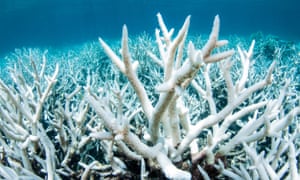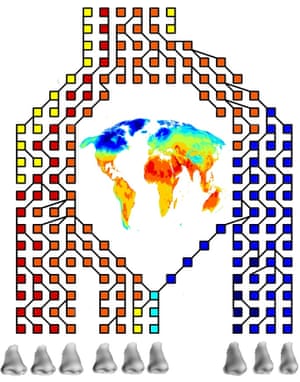
https://www.theguardian.com/environment/2017/mar/10/great-barrier-reef-coral-bleaching-worsens-as-scientists-fear-heatwaves-impact The Great Barrier Reef has sustained significant damage due to coral bleaching, according to the Great Barrier Reef Marine Park Authority. High water temperatures are to blame. The worst-to-date mass bleaching event took place in 2016 and there is evidence that another mass bleaching event is taking place before the corals have had time to possibly recover.

https://www.theguardian.com/science/2017/mar/16/climate-shaped-the-human-nose-researchers-say An article from the Guardian reporting how climate shaped the evolution of the human nose. The research was done at Penn State and published in PLOS Genetics. The study, based on variations of shapes of human noses, confirmed that nose shape is "highly heritable" and found a link between nostril width and temperature. Nostrils function to warm the air.

https://www.nytimes.com/2017/03/12/business/lloyd-conover-dead-inventor-of-groundbreaking-antibiotic.html A NYT obit for Lloyd Conover, who discovered tetracycline. He also discovered that natural products could be modified synthetically to make them more effective. Taxol, a frontline cancer chemotherapy is made partly from the bark of a yew tree and partly by chemical synthesis.

http://hyperallergic.com/361446/picturing-math-at-the-metropolitan-museum-of-art/ This is from the blog Hyperallergic about a new exhibit at the Met on artistic expressions of math. Picturing Math has prints that go back seven centuries and also includes some modern and contemporary pieces.
https://www.nytimes.com/2017/03/16/world/canada/trump-budget-canada-great-lakes.html?_r=0 Article for NYT about the 2018 Trump budget which proposes to gut the Great Lakes Restoration Initiative which was tasked with water clean up and algae removal on both sides of the border. This is rightly perceived as an unwillingness to collaborate with our northern neighbor on environmental remedy.

http://bigthink.com/strange-maps/a-map-of-lexical-distances-between-europes-languages This is a link from the blog bigthink which shows the "lexical" distances between Europe's languages. The smaller the distance between languages, the more words are shared. Maybe this is obvious but I love information rendered in graphical format and all maps. The map also shows orphan languages (without families) like Albanian and Greek.
https://www.nytimes.com/2017/03/17/opinion/sunday/the-seasons-arent-what-they-used-to-be.html?_r=0 From the NYT Sunday Review section an opinion piece about the start of Spring Monday (for us) and the disconnect for plants and animals. Spring peepers, for the writer, were unleashed in February in Tennessee for example. The spring emergence of leaves, amphibians, birds and insects is advancing 2.8 days per decade in the Northern Hemisphere. Did you know what phenology is? It's the study of the seasonal timing of biological events.

https://www.nytimes.com/2017/03/20/upshot/why-cystic-fibrosis-patients-in-canada-outlive-those-in-the-us.html?_r=0 Article from the NYT reporting a publication from the Annals of Internal Medicine that sufferers from cystic fibrosis have longer life spans in Canada than US although the life spans in both countries increased. It should be noted that more CF sufferers in Canada received lung transplants although few in general received the transplants so there must be other factors involved.

https://www.nytimes.com/2017/03/17/health/global-health-fogarty-international-center-viruses.html?_r=0 This is an article from the NYT about the 2018 budget plan to eliminate the Fogarty Center, part of the NIH, which is a reference lab for the WHO and collects and shares information about disease outbreaks, with the idea of developing vaccines. These various reference labs are considered "sentinel labs" and only two are in American hands.

https://earth.nullschool.net/ This is a neat graphic showing wind, weather, ocean and pollution conditions as predicted by supercomputers. It's an interactive, animated map.
http://www.huffingtonpost.com/entry/critical-thinking-pseudoscience_us_58d14903e4b0be71dcf83b0e This is a link to a Huff Post article about a Humanities course at North Carolina State University investigating historical frauds. A study was done of students in the class which found that participation in the course had reduced students' belief in psuedoscience and developed their critical thinking skills.
https://www.forbes.com/sites/tarahaelle/2017/03/23/breaking-the-cold-chain-new-vaccine-doesnt-need-refrigeration/#38807e457912 From Forbes magazine a report of a rotavirus vaccine developed in India that doesn't need refrigeration. Rotavirus causes 1/3 of all cases of diarrhea and kills a lot of children. Doctors Without Borders, the Cincinnati Children's Hospital and the Serum Institute of India conducted the Phase III clinical trial. This disease affects people without access to electricity and water which is why this vaccine is important.

https://www.nytimes.com/2017/03/24/world/asia/china-air-pollution-smog-climate-change.html This is an article from the NYT about the effects of climate change in China. As reported in the journal Science Advances, the "airpocalypse" that fell on Beijing in January of 2013 was due to unusually stagnant air brought on by climate change.

https://www.nytimes.com/2017/03/24/opinion/the-real-threat-to-national-security-deadly-disease.html An editorial in the NYT about the importance of infectious diseases to national security. The editorial writers fume about the cuts in the State Department, NIH (18%) and United States Agency for International Development (28%) budgets and the increase in military spending. The spread of antibiotic resistant bacteria is also mentioned as a global threat. There is as yet no licensed vaccine for Ebola or plan to deal with an epidemic.

No comments:
Post a Comment